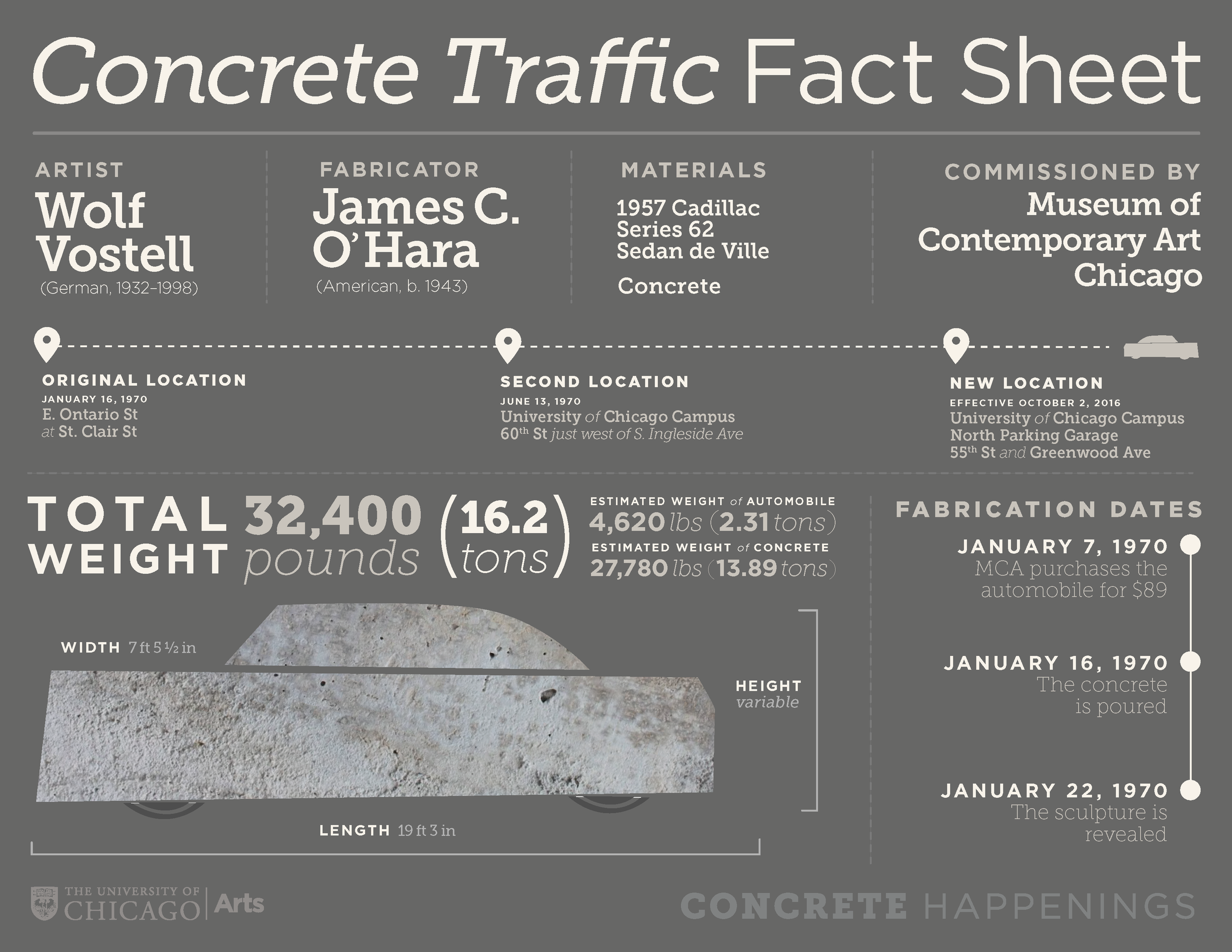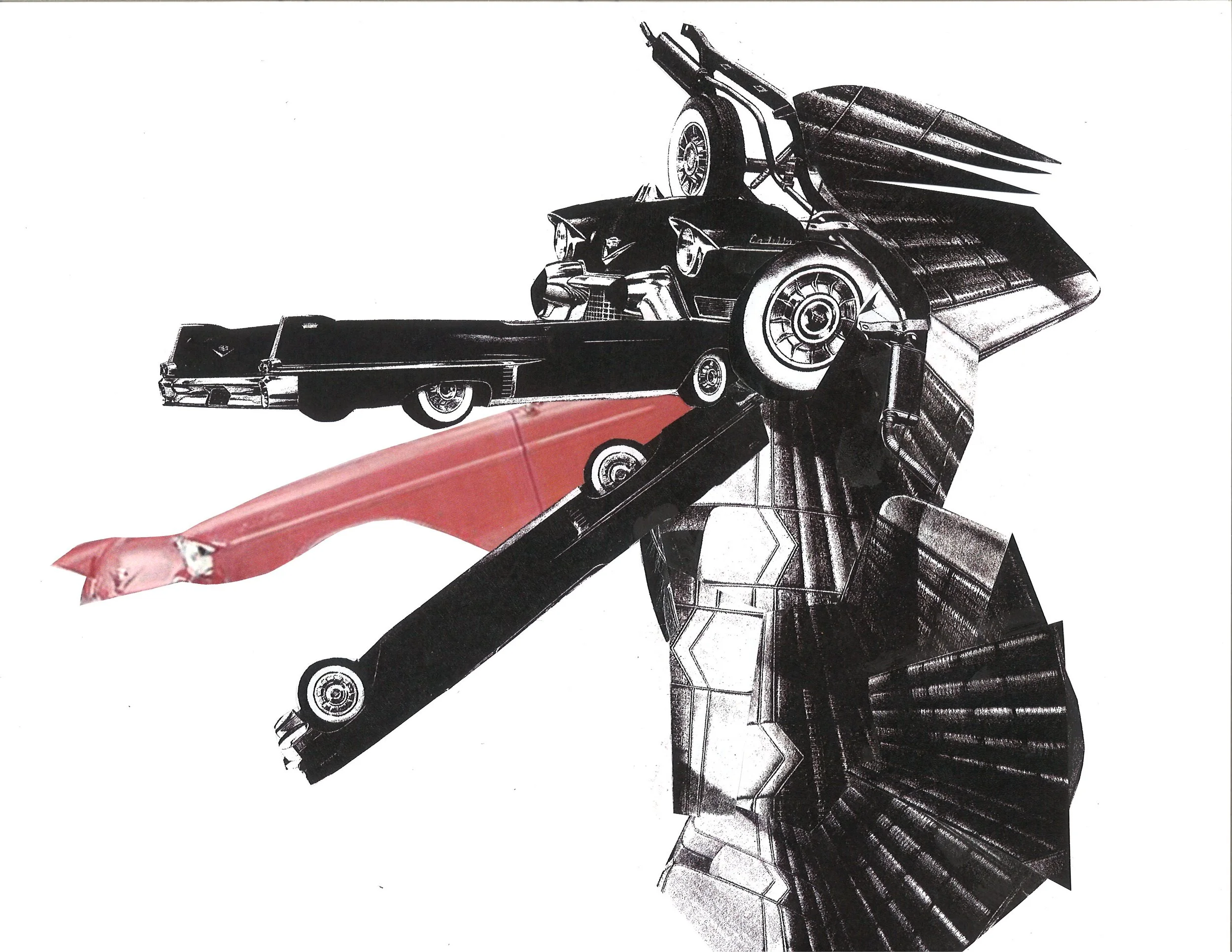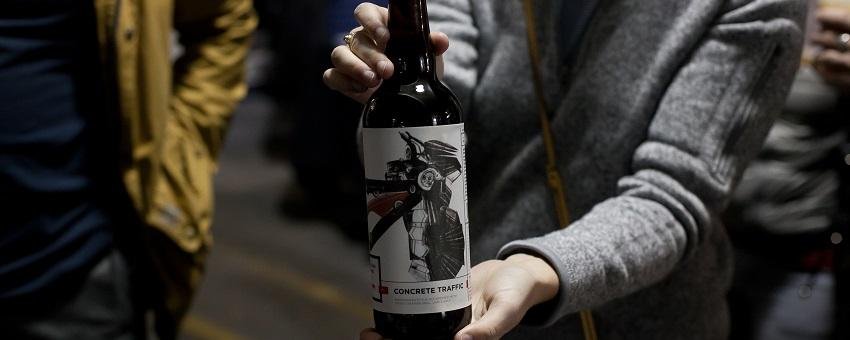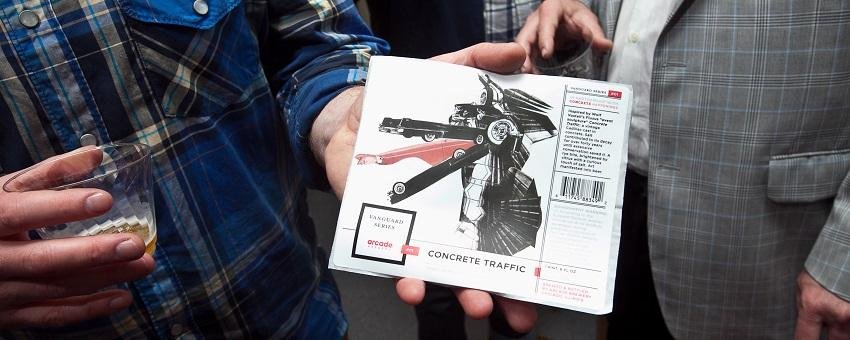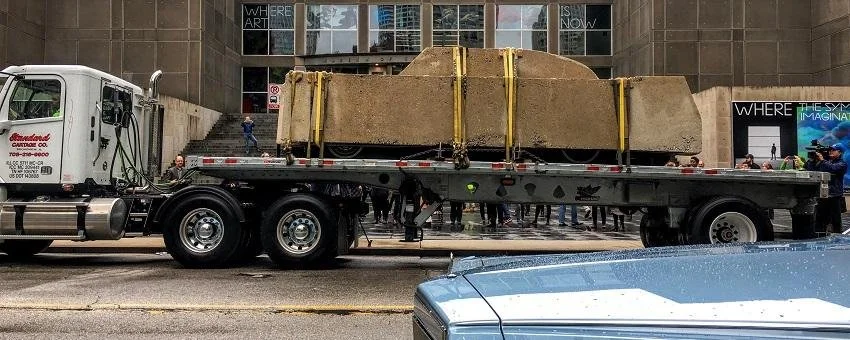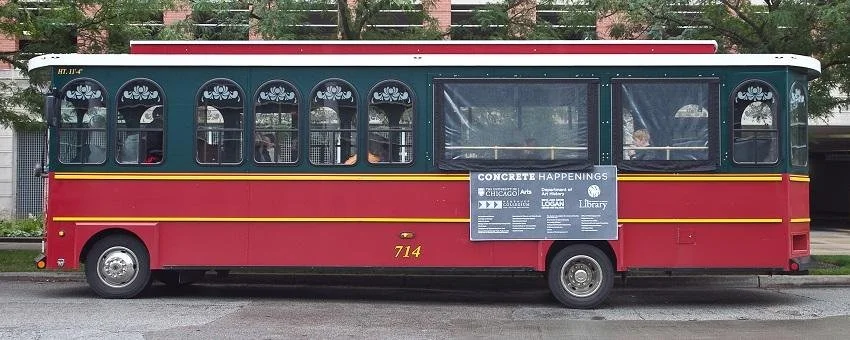FALL 2016 – SPRING 2017
Concrete happenings
Don't just look at art. Grapple with it.
Concrete Happenings invited art-lovers and car-lovers, artists and scholars, drivers and pedestrians to confront the power of public art—the strange power of a massive sculpture produced by Fluxus artist Wolf Vostell. In 1970, in Chicago, Vostell encased a Cadillac in concrete. The product of that “happening,” Concrete Traffic, was installed in the University of Chicago Campus North Parking Garage on October 1, 2016. It served as the provocation for a comprehensive suite of exhibitions and interactive public programs—performances, screenings, talks, art workshops, happenings—that offered unique opportunities to engage with a crucial art historical moment and movement, and to explore the intensities with which an artwork can form and transform its publics.
“Concrete Happenings” is organized by UChicago Arts in partnership with the University of Chicago’s Department of Art History, Neubauer Collegium for Culture and Society, Smart Museum of Art, University Library: Special Collections Research Center, and Reva and David Logan Center for the Arts.
Concrete Traffic
Created 1970 / Originally installed 1970 / Reinstalled 2016
Concrete, 1957 Cadillac Series 62 Sedan de Ville
Width: 89.5 in (173.99 cm)
Length: 231 in (25.4 cm)
Weight: 16.2 tons
Located at Campus North Parking Garage
5525 S Ellis Ave
Commissioned by the Museum of Contemporary Art Chicago
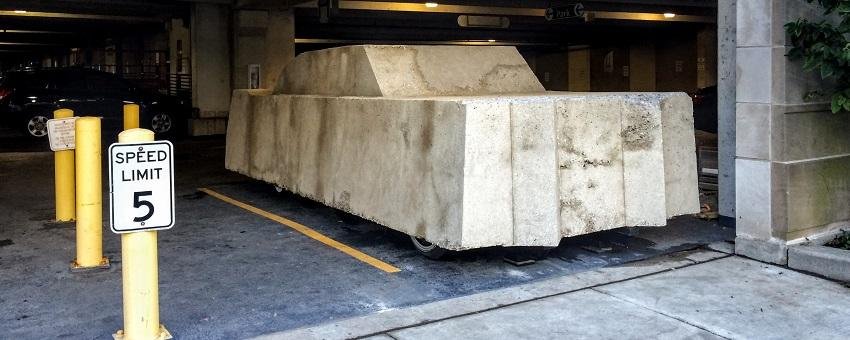
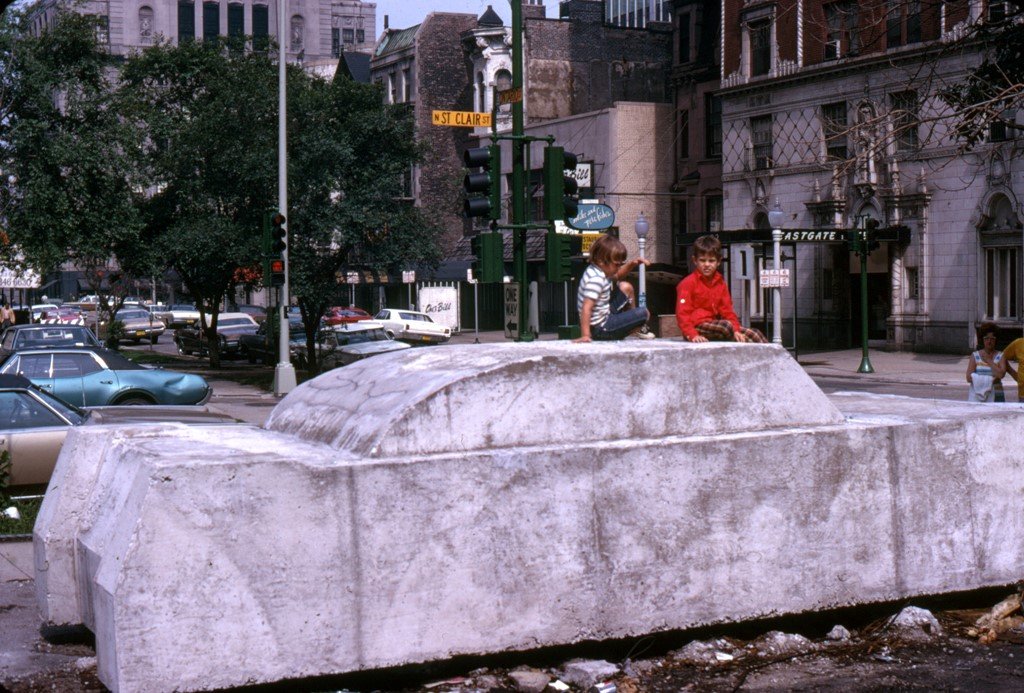
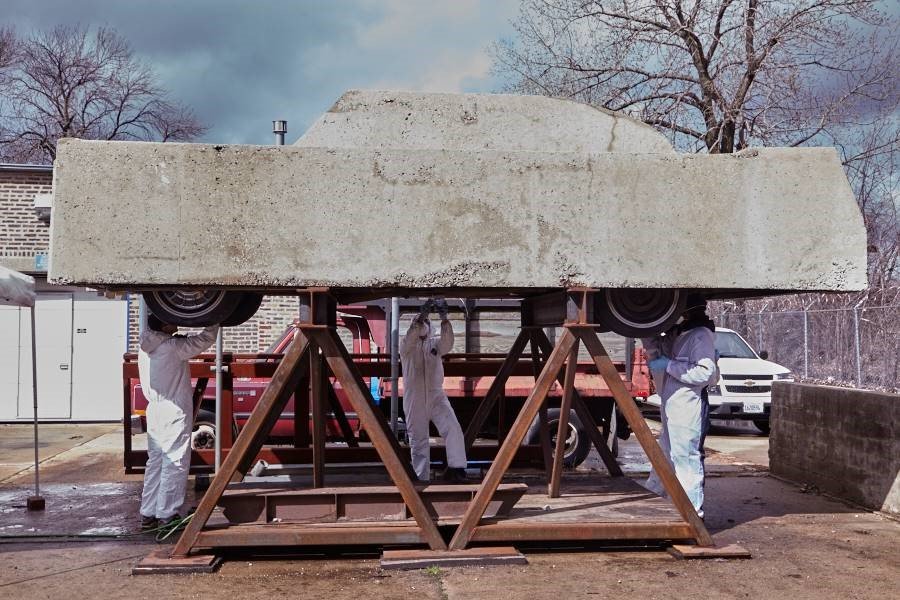
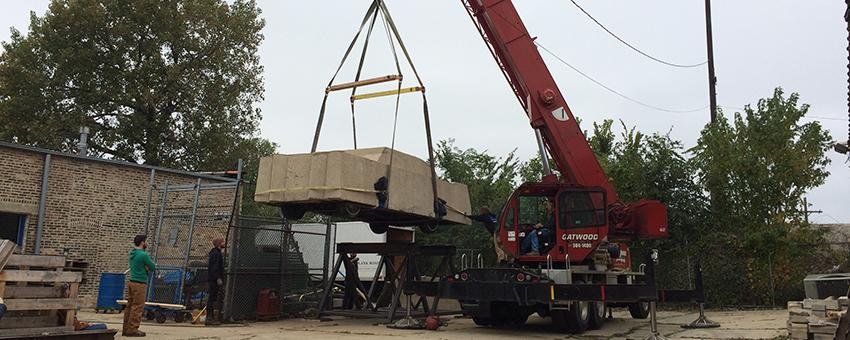
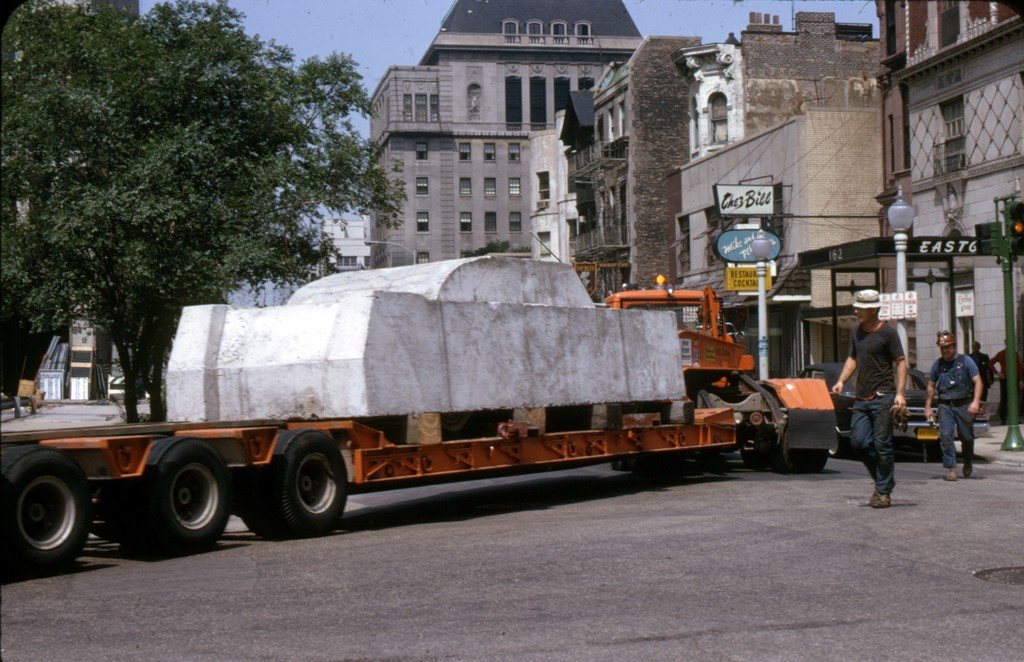
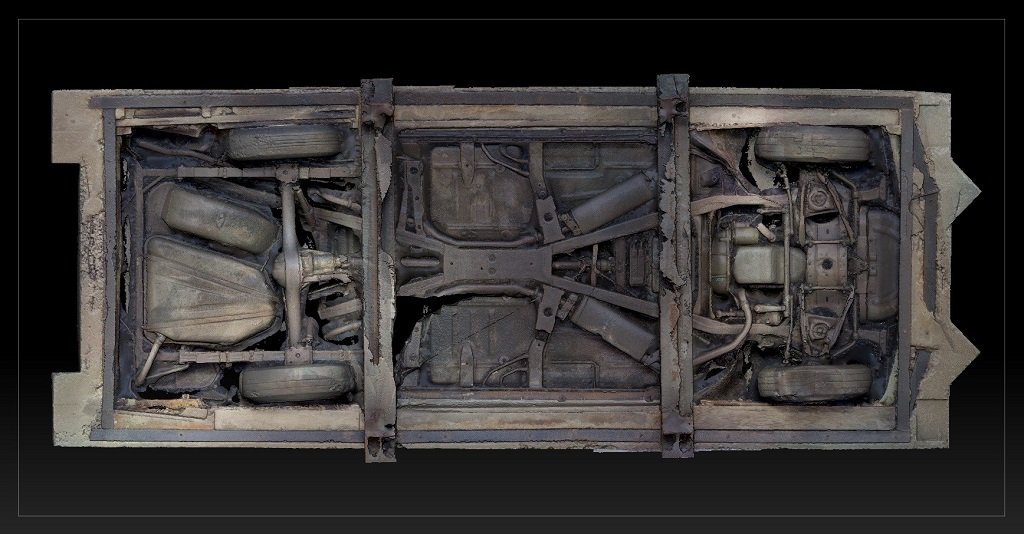
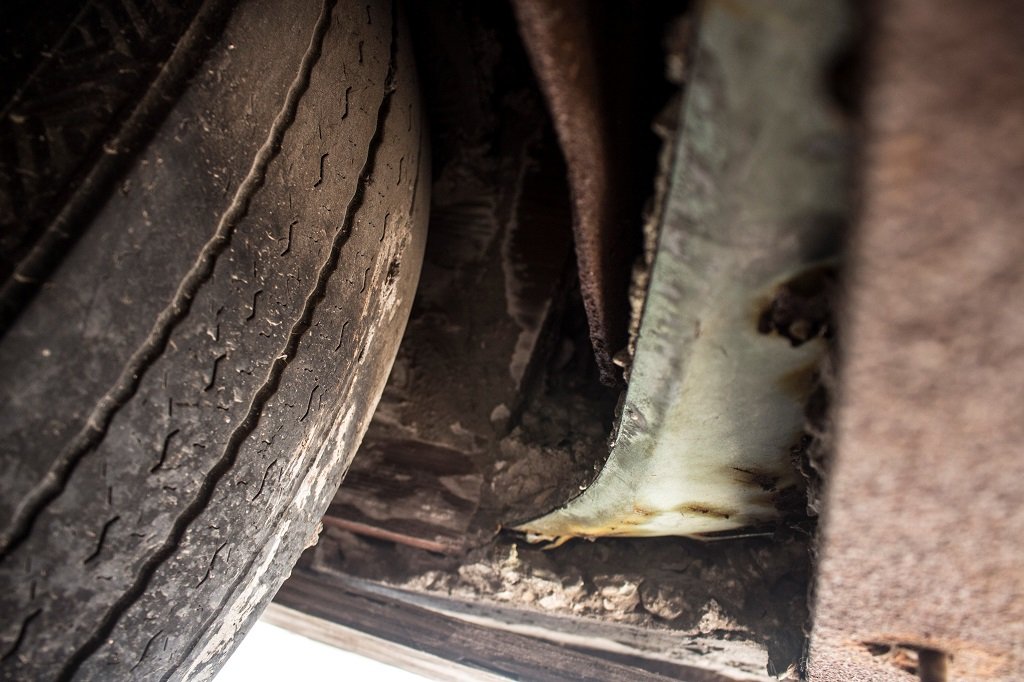
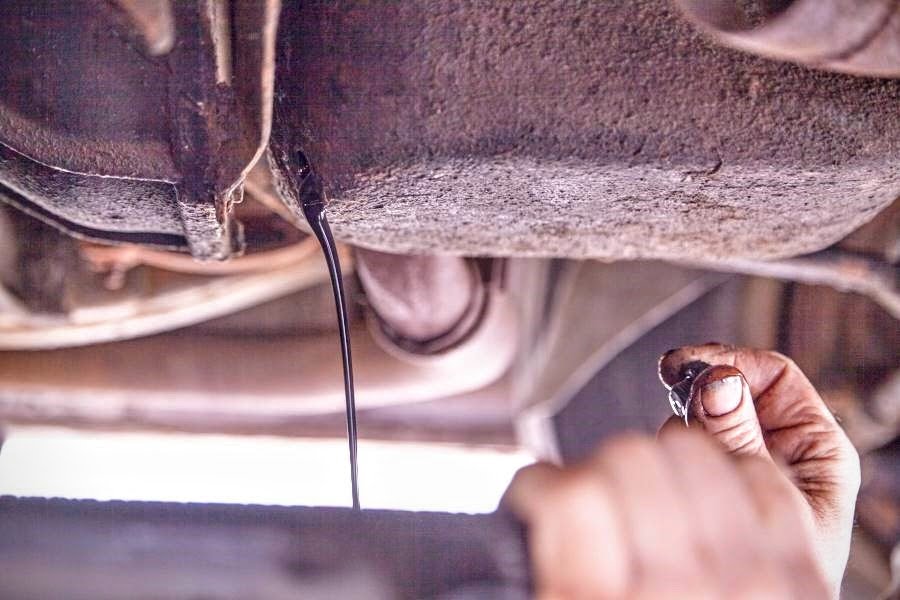
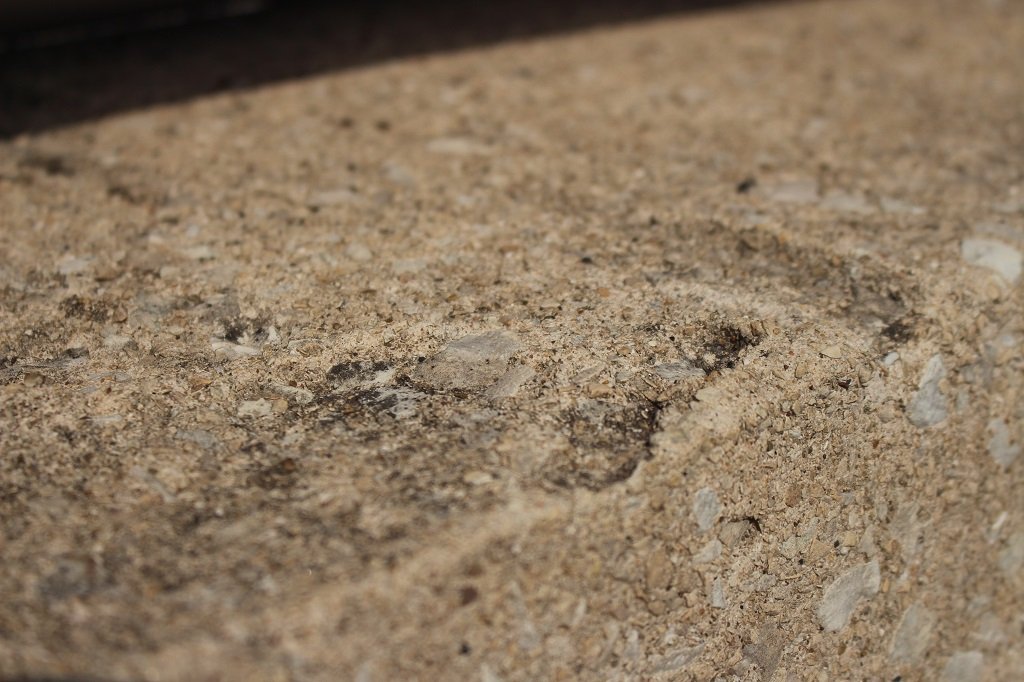
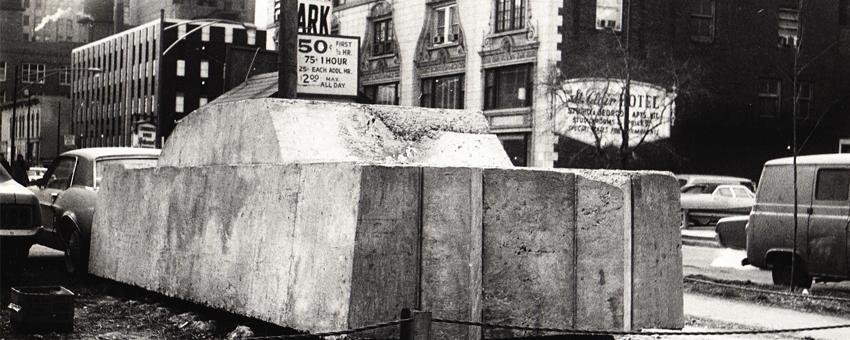
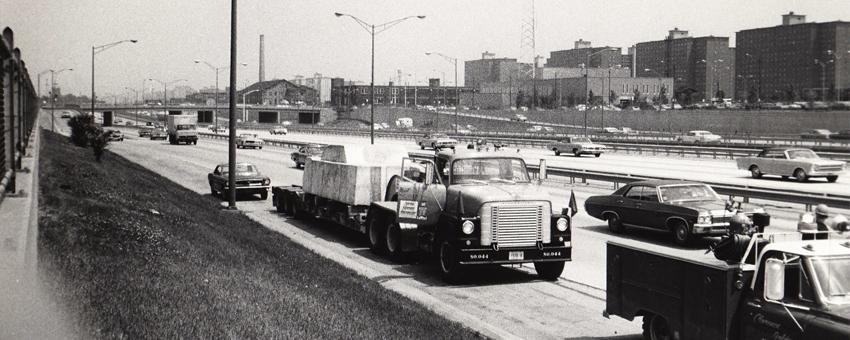

About Concrete Traffic
Conceived by Fluxus artist Wolf Vostell (1932–1998) as an “instant happening” and an “event sculpture,” Concrete Traffic was commissioned by the Museum of Contemporary Art Chicago (MCA). On the morning of January 16, 1970, in a busy Chicago commuter parking lot, Chicago artisans brought Vostell’s vision to life, pouring concrete over a 1957 Cadillac deVille to create the monumental concrete sculpture. Concrete Traffic spent several months in the lot until the artist and the MCA gifted the sculpture to the University of Chicago, where it was sited in an outdoor lot at 60th Street and South Ingleside Avenue—the current site of the Reva and David Logan Center for the Arts.
Concrete Traffic spent nearly 40 years exposed to the elements, until a major four-year conservation effort was undertaken between June 2012 and September 2016, complemented by material investigation and a series of workshops. (For more information about these efforts, visit ‘Material Matters’ at neubauercollegium.uchicago.edu).
As this work came to a close, a partnership of UChicago arts organizations envisioned Concrete Happenings.
Wolf Vostell, Berlin 1981
About the artist
Wolf Vostell (1932–1998) was a German artist best known for video art and installations involving televisions, automobiles, and other household objects.
A key mode for Vostell was the “happening,” an art event or situation intended to interrupt everyday life that often involved audience participation and some measure of improvisation or chance. For many of Vostell’s happenings, like most performance-based practices, very little survives. However, Vostell often held on to the sculptural remnants of his performances and referred to them as happening “fallouts.”
Concrete Traffic marks a shift in his practice from generating accidental happening fallouts to producing conceptually designed formal sculptures.
About Fluxus
Fluxus is a loosely-defined global, performance-based, avant-garde art movement. Associated artists such as Wolf Vostell, Joseph Beuys, Allan Kaprow, and Yoko Ono sought to involve viewers in the creation of art, rather than the result. As Fluxus works most often took the form of events or happenings that viewers experienced merely by chance, the movement is typically represented by ephemeral artifacts such as fliers, photographs, and film documents.
Concrete happenings: Concrete Traffic Conversation
Lynne Warren (Curator, Museum of Contemporary Art Chicago) and Christine Mehring (Professor and Chair, Department of Art History, The University of Chicago) discuss the history of Wolf Vostell's sculpture “Concrete Traffic” (1970). The discussion took place at the MCA as part of Concrete Traffic's Procession to the University of Chicago on September 30, 2016.
CONSERVING CONCRETE TRAFFIC
This documentary tells the story behind the conservation of Concrete Traffic—a 1957 Cadillac encased in Concrete that was produced by Fluxus artist Wolf Vostell in Chicago in 1970. After decades exposed to the elements, a team of art historians, conservators, engineers, and others undertook a multi-year conservation project that culminated with the return of the sculpture to the University of Chicago in Fall of 2016.
Related: ‘Material Matters’ at neubauercollegium.uchicago.edu
Concrete Traffic Procession to the University of Chicago
On September 30, 2016, Fluxus artist Wolf Vostell’s concrete-covered Cadillac, Concrete Traffic (1970), returned to the University of Chicago during a public procession that traced the history of the colossal sculpture. The program began on the plaza outside of the Museum of Contemporary Art, where Concrete Traffic was joined by a number of classic Cadillacs and a cement truck as a backdrop for a free public discussion with Lynne Warren, MCA Curator, and Christine Mehring, Professor and Chair, Department of Art History at UChicago, who initiated and directed the sculpture's conservation and return. Afterward, the sculpture traveled past its original location on the site of the present-day Arts Club of Chicago, where it was greeted by a performance inspired by Danger Music Number 17, a score by Fluxus artist Dick Higgins. Finally, Concrete Traffic made its way past Midway Studios and the Logan Center for the Arts, the site of its original location at the University of Chicago, before arriving at its new location on the north side of campus in the vicinity of the Smart Museum of Art.
exhibitions & programs
Left: Detail of Wolf Vostell’s Concrete Traffic, 1970, after it arrived at its new location at the east entrance to the University of Chicago Campus North Parking Garage. (Photo by Erik L. Peterson).
-
The Logan Center for the Arts, Neubauer Collegium, Smart Museum of Art, and Special Collections—all free and within walking distance from the Concrete Traffic sculpture site—delved into the stories behind Concrete Traffic through a series of exhibitions.
Retrogarde
November 11, 2016–January 1, 2017 | Reception: November 11, 2016, 6–8pm
Exhibition hours: Tuesday through Saturday, 9am–9pm; Sunday, 11am–9pm
Logan Center Gallery, Reva and David Logan Center for the Arts, 915 East 60th StreetRetrogarde is an international group exhibition that explores contemporary artists’ recuperation and appropriation of avant-garde strategies, histories, and archives in their work. Conceptually and formally, the works in this exhibition adopt a series of recognizable avant-garde forms—fusing play with the profane; detourning language, space, and matter; and working through performative actions and interventions—to address the politics of everyday life. Taken together these works highlight the continued relevance of avant-garde perspectives today. Yet the artists’ attitude towards this lineage is not one of blind veneration but rather pervasive disobedience, mirroring the transgressive actions of their predecessors. Consequently, Retrogarde infuses other viewpoints, narratives, and contexts to open up our collective reading of avant-garde traditions. Artists in the exhibition include Caroline Bergvall, Samson Kambalu, Matthew Metzger, Catherine Sullivan and Samson Young.
Curator: Yesomi Umolu, Exhibitions Curator, Logan Center for the Arts.
Presented by Logan Center Exhibitions.
Instructions for a Chicago Fluxus Opening
Sunday, January 22, 2017, 3–6pm
Neubauer Collegium for Culture and Society (5701 South Woodlawn Avenue), Special Collections Research Center, University of Chicago Library (1100 East 57th Street), Smart Museum of Art (5550 South Greenwood Avenue)A set of "instructions"—inspired by participatory Happenings orchestrated by Fluxus artist Wolf Vostell—will guide you across the University of Chicago campus during this opening celebration for three related exhibitions: Fantastic Architecture (Neubauer Collegium), Concrete Poetry, Concrete Book (Special Collections Research Center), and Vostell Concrete (Smart Museum). Enjoy a variety of free programs, food, and drinks at the three locations. A free shuttle will run between locations. Free, open to all. Drop by or RSVP on Facebook.
Presented by the Neubauer Collegium for Culture and Society, Special Collections Research Center, and Smart Museum of Art. The exhibitions and related programming have been made possible in part by the generous support of the Pamela and R. Christopher Hoehn-Saric Exhibition Fund, the Graham Foundation for Advanced Studies in the Fine Arts, the Swiss Benevolent Society, the Austrian Cultural Forum New York, SmartPartners, and Ozinga Bros., Inc.
Concrete Poetry, Concrete Book: Artists’ Books in German-speaking Space after 1945
January 17–March 17, 2017 | Reception: Sunday, January 22, 2017, 3–6pm
Exhibition hours: Monday through Friday, 9am–4:45pm; and, when University of Chicago classes are in session, Tuesdays and Wednesdays, 9am–5:45pm
Special Collections Research Center, University of Chicago Library, 1100 East 57th StreetIn the same decades that artists affiliated with Fluxus explored action-based, performative strategies set on disrupting the conventions of both art and everyday life, the book emerged as a significant artistic preoccupation. Not only were books important for anthologizing ephemeral action-based art, but they became in their own right sites of artistic experimentation with cognitive, visual, and tactile experience. Drawing on the remarkable collection of rare artists’ books housed in the University of Chicago Library, Concrete Poetry, Concrete Book explores how artists in Austria, Germany, and Switzerland investigated the material and technical forms of the book. Referring to the way that language takes up space on the page, arrests the eyes, and insists on physical interaction, works of konkrete poesie (concrete poetry) tested the material display of language, focusing on the object-quality of letters and words. To accommodate this dual staging of textual production and reception, artists’ books took on unusual forms, as in Gerhard Rühm’s kinetic book bewegung (motion, 1964) and Hansjörg Mayer’s reinvention of the alphabet in the fold-out book typoaktionen (type-actions, 1967). At the same time that artists’ books often activate the process of reading, they also deemphasize textual cognition, foregrounding instead touch and materiality, as exemplified in die-cut multi-colored cellophane pages of Dieter Roth’s bilderbücher (picture-books, 1957) and in Wolf Vostell’s unreadable 20-pound Betonbuch (Concrete Book, 1971). In tandem with Concrete Happenings, interactive workshops will provide unique opportunities for hands-on engagement with artists’ books, and a series of public lectures will provide further perspective on the concrete questions they raise about language, materiality, performance, and collaboration.
Curator: Caroline Lillian Schopp, PhD candidate in the Department of Art History.
Presented by the University of Chicago Library, with additional support generously provided by the Swiss Benevolent Society and the Austrian Cultural Forum New York.Fantastic Architecture: Vostell, Fluxus, and the Built Environment
January 22–March 17, 2017 | Reception: Sunday, January 22, 2017, 3–6pm
Exhibition hours: Monday through Friday, 11am–5pm
Neubauer Collegium for Culture and Society, 5701 South Woodlawn AvenueTaking its title and inspiration from the seminal publication Fantastic Architecture (1969), edited by Wolf Vostell and Dick Higgins and published by Something Else Press, this exhibition presents various approaches to architecture, urban space, and the built environment within an expanded international community of Fluxus and related artists in the late 1960s and early 1970s. Fantastic Architecture is presented in conjunction with the re-siting, following a major conservation treatment, of Wolf Vostell’s Concrete Traffic (1970), a monumental event-sculpture in the University of Chicago’s Campus Art Collection. The exhibition contextualizes Concrete Traffic in relation to Vostell’s other related works from the period, including photomontage proposals for alterations to architectural and urban spaces and event scores for happenings intended for specific cities, as well as the work of his artistic peers and interlocutors. In Europe and the United States alike, the postwar period saw massive transformations of the urban landscape, the construction and expansion of freeway systems, and the rise of automobile culture, and artists of the time responded to these developments in a variety of ways. Like its eponymous exemplar, the exhibition embraces the porousness and intellectual ferment of the experimental art world of the time, a context in which forms and concepts circulated among an international community of artists whose political and aesthetic projects did not always strictly align. Also included are works and projects by Fluxus impresario George Maciunas, Japanese collective Hi Red Center, happenings inventor Allan Kaprow, conceptual artist Douglas Huebler, and artist and poet Rosemary Mayer, and others.
Curator: Jacob Proctor, Curator, Neubauer Collegium for Culture and Society.
Presented by the Neubauer Collegium for Culture and Society, with additional support from the Graham Foundation for Advanced Studies in the Fine Arts.Vostell Concrete, 1969–1973
January 17–June 11, 2017 | Reception: Sunday, January 22, 2017, 3–6pm
Exhibition hours: Tuesday through Sunday, 10am–5pm; Thursday until 8pm
Smart Museum of Art, 5550 South Greenwood AvenueVostell used concrete as an actual material and artistic motif in a surprising number of ways in the late 1960s and early 70s. During this time, Vostell mobilized concrete’s ambivalent connotations of permanence and inflexibility, strength and violence, to engage with postwar urbanism, particularly German reconstruction and American urban renewal; with unrest and war, including the civil rights marches in Selma, the Paris student protests, the Vietnam and Cold wars; and with the international, if not yet global world, particularly as manifest in transatlantic travel, postcards, and the Munich Olympics. Vostell Concrete is animated by questions of why the materials of art making matter and what they signify. It features the artist’s little known, first uses of concrete and redresses a too-limiting understanding of Vostell as a mere performance artist or belated German Pop artist. Drawn from the Smart Museum and other local, national, and international collections, the approximately 45 works on view span a variety of media, from sculpture to film, performance, collage, watercolor, and printmaking.
Curators: Christine Mehring, Professor and Chair, Department of Art History, in collaboration with Diane Miliotes, Interim Curator of Modern Art and Design, Smart Museum of Art, and Caroline Lillian Schopp, Curatorial Research Associate and PhD Candidate in Art History.
This exhibition has been made possible in part by the Smart Museum’s Pamela and R. Christopher Hoehn-Saric Exhibition Fund, Amy L. Gold, the Graham Foundation for Advanced Studies in the Fine Arts, and SmartPartners.
-
From fall 2016 to spring 2017, a range of free, interdisciplinary programs across campus engaged both scholarly and general audiences in the rich themes surrounding Concrete Happenings.
Concrete Traffic Procession to the University of Chicago
Friday, September 30, 2016, 12–4pm
Museum of Contemporary Art Chicago (220 East Chicago Avenue) to Arts Club of Chicago (201 East Ontario Street) to University of Chicago campusFluxus artist Wolf Vostell’s concrete-covered Cadillac, Concrete Traffic (1970), returns to the University of Chicago during a public procession that traces the history of the colossal sculpture. The program begins at noon on the plaza outside of the Museum of Contemporary Art, where Concrete Traffic will be joined by a number of classic Cadillacs and cement trucks as a backdrop for a free public discussion with Lynne Warren, MCA Curator, and Christine Mehring, Professor and Chair, Department of Art History at UChicago, who initiated and directed the sculpture's conservation and return. Afterward, the sculpture will travel past its original location on the site of the present-day Arts Club of Chicago, where it will be greeted by a performance inspired by Danger Music Number 17, a score by Fluxus artist Dick Higgins. Finally, Concrete Traffic will make its way past Midway Studios and the Logan Center for the Arts, site of its original location at the University of Chicago, before arriving at its new location on the north side of campus in the vicinity of the Smart Museum of Art.
Presented by UChicago Arts in partnership with the Museum of Contemporary Art Chicago, the Arts Club of Chicago, and the Smart Museum of Art, and is made possible by the generous support of Ozinga Bros., Inc., and the University's Office of Civic Engagement.
Concrete Happenings Arts Lobby
September 30, 2016–March 3, 2017
Exhibition hours: Tuesday through Friday, 10am–4:30pm
Rockefeller Memorial Chapel, 5850 South Woodlawn AvenueHarold Haydon, alumnus, professor, and stained glass artist, whose work adorns Rockefeller Chapel, was a contemporary to Wolf Vostell, and head of Midway Studios, the art center on campus in 1970, when Concrete Traffic arrived at the University. Letters documenting Haydon’s foresight in acknowledging the historical significance of Concrete Traffic, along with the gift arrangement between the Museum of Contemporary Art Chicago and the University will be on view, while documentary footage of the original installation of the sculpture on campus will be exhibited in the lobby to orient chapel visitors to the Concrete Happenings events throughout the campus.
Presented by Rockefeller Memorial Chapel.
Drive-In Happening
Friday, October 14, 2016, 6–8pm
The University of Chicago, Campus North Parking Garage, 5525 South Ellis AvenueThe University of Chicago opens Concrete Happenings with a Fluxus-inspired screening in the concrete bowels of a parking garage. For one night only, a section of the University's Campus North Parking Garage will be closed to traffic and its parking spots turned into screening spaces for several of artist Wolf Vostell's experimental film and video works related to automobiles. Short looping works like Berlin-Fieber (1973), a happening that involved cars driving and parking in different locations in Berlin, and Ruhender Verkehr (1969), a repeated fragment of a 16mm documentary of the creation of Vostell's first concrete car sculpture, will be projected onto the walls and floors of the garage, between and behind real cars on the ground and lower levels of the partially empty parking structure. The screening, sculpture, and Concrete Happenings initiative will be introduced by Christine Mehring (Professor and Chair, Department of Art History) and Lisa Zaher (UChicago Arts Conservation Research Fellow). The evening also features German food and the public debut of Arcade Brewery's Concrete Traffic, a biting rye beer inspired by Vostell's colossal sculpture.
Presented by UChicago Arts and the Smart Museum of Art, with funding support generously provided by the University's Department of Cinema and Media Studies and the Film Studies Center.
Humanities Day
Conserving Public Sculpture: Wolf Vostell's Concrete Traffic
Saturday, October 15, 2016, 3:30pm
The University of Chicago, Campus North Parking Garage, 5525 South Ellis AvenueAs part of the University of Chicago's annual Humanities Day, Christine Mehring (Professor, Art History) and Lisa Zaher (UChicago Arts Conservation Research Fellow) discuss the material challenges and aesthetic decisions that guided the conservation of Wolf Vostell's monumental public sculpture consisting of a 1957 Cadillac covered in concrete. This talk will take place in the presence of the sculpture in its new location, the Campus North Parking Garage.
Space is limited. Advanced registration required at humanitiesday.uchicago.edu.
Presented by the Division of the Humanities.
Opening Reception: Retrogarde
Friday, November 11, 2016, 6–8pm
Logan Center Gallery, Reva and David Logan Center for the Arts, 915 East 60th StreetRetrogarde is an international group exhibition that explores contemporary artists’ recuperation and appropriation of avant-garde strategies, histories, and archives in their work. Conceptually and formally, the works in this exhibition adopt a series of recognizable avant-garde forms—fusing play with the profane; detourning language, space, and matter; and working through performative actions and interventions—to address the politics of everyday life. Taken together these works highlight the continued relevance of avant-garde perspectives today. Yet the artists’ attitude towards this lineage is not one of blind veneration but rather pervasive disobedience, mirroring the transgressive actions of their predecessors. Consequently, Retrogarde infuses other viewpoints, narratives, and contexts to open up our collective reading of avant-garde traditions. Artists in the exhibition include Caroline Bergvall, Samson Kambalu, Matthew Metzger, Catherine Sullivan and Samson Young. Exhibition hours: Tuesday through Saturday, 9am–9pm; Sunday, 11am–9pm.
Curator: Yesomi Umolu, Exhibitions Curator, Logan Center for the Arts.
Presented by Logan Center Exhibitions.Artist Talk with Samson Kambalu and Jennifer Wild
Saturday, November 12, 2016, 2pm
Logan Center Screening Room, Reva and David Logan Center for the Arts, 915 East 60th StreetA conversation with artist Samson Kambalu and University of Chicago Associate Professor Jennifer Wild (Department of Cinema and Media Studies), moderated by Yesomi Umolu, Logan Center Exhibitions Curator. Presented in conjunction with the exhibition Retrogarde, the discussion will address alternative readings of avant-garde art and cinema in Kambalu's and Wild's artistic and scholarly work, respectively.
Presented by Logan Center Exhibitions and the Counter Cinema/Counter Media Project at the Center for the Study of Gender and Sexuality.
Symposium: Conserving Industrial Materials and Processes in Art
November 18–19, 2016
The University of Chicago and the Art Institute of ChicagoExperimentation with industrial materials and technology distinguishes many 20th and 21st century avant-garde practices. Concrete Traffic’s combination of industrial materials and technical components reinforces the need for further scientific analysis and information exchange between the fine and applied arts, industry and science, as well as between the professionals who conserve industrial materials and consumer technologies in diverse contexts. A two-day symposium, held in partnership with the Art Institute of Chicago, will facilitate this exchange, bringing together leading practitioners in conservation and collection care for presentations and demonstrations, exploring how a thorough knowledge of industrial materials and processes can inform art historical interpretation. The symposium includes a close-up look at the conservation of various objects by the Hungarian born Bauhaus artist László Moholy-Nagy in the exhibition Moholy-Nagy: Future Present at the Art Institute. Moholy-Nagy stands as a precursor to Vostell in his use of industrial materials, his performative use of media, and experiments with film.
Presented by the Department of Art History, the Richard and Mary L. Gray Center for Arts and Inquiry, and the Chicago Center for Contemporary Theory (3CT), in collaboration with the Art Institute of Chicago. Additional support has been generously provided by the Goethe-Institut, and the University of Chicago's Neubauer Collegium for Culture and Society, Humanities Division, Franke Institute for the Humanities, UChicago Urban, the Department of Germanic Studies, and the Film Studies Center.
Lampo Performance with Charles Curtis
Friday, December 9, 2016, 8pm
Logan Center Performance Penthouse, Reva and David Logan Center for the Arts, 915 East 60th StreetSolo concert by cellist Charles Curtis weaves classical performance with musical experimentation. The program includes Rice and Beans for Charles Curtis, a handmade score created by Fluxus artist Alison Knowles that is composed of wet flax pulp, lentils, rice, and a tangle of strings poured out flat, pressed, and dried.
Presented by the Smart Museum of Art and Lampo.
Reading Fluxus Film
Friday, January 20, 2017, 4pm workshop, 5pm screening
BING Art Books, Stony Island Arts Bank, 2nd floor, 6760 S. Stony Island Ave. Chicago, IL 60649A hands-on workshop on artists' books precedes a screening of word-based films, presented in conjunction with the exhibition Concrete Poetry, Concrete Book at the Special Collections Research Center, curated by Caroline Schopp, UChicago Ph.D. candidate in Art History. A panel discussion will follow the screening, introduced by media art historian Bruce Jenkins (SAIC) and including Jenkins, Schopp, Lisa Zaher (UChicago Arts Conservation Research Fellow and Ph.D., Art History), and Fluxus film scholar Jacob Proctor (Curator, Neubauer Collegium). Like the Fluxus books and kits on view in the exhibition and workshop—books that seek to enhance our awareness of human consciousness through hands-on, multi-sensory encounters—these word-based films explore the correspondences between material properties of film, perceptual acts of film viewing, and cognitive acts of reading. Our discussion will consider the political effectiveness of Fluxus practices towards acts of political resistance. Organized by Caroline Schopp and Lisa Zaher.
Presented by UChicago Arts, the Department of Art History, and Black Cinema House, with additional support provided by the Department of Cinema and Media Studies and the Film Studies Center.
Instructions for a Chicago Fluxus Opening
Sunday, January 22, 2017, 3–6pm
Neubauer Collegium for Culture and Society (5701 South Woodlawn Avenue), Special Collections Research Center, University of Chicago Library (1100 East 57th Street), Smart Museum of Art (5550 South Greenwood Avenue)A set of "instructions"—inspired by participatory Happenings orchestrated by Fluxus artist Wolf Vostell—will guide you across the University of Chicago campus during this opening celebration for three related exhibitions: Fantastic Architecture (Neubauer Collegium), Concrete Poetry, Concrete Book (Special Collections Research Center), and Vostell Concrete (Smart Museum). Enjoy a variety of free programs, food, and drinks at the three locations. A free shuttle will run between locations.
Free, open to all. Drop by or RSVP on Facebook.
Presented by the Neubauer Collegium for Culture and Society, Special Collections Research Center, and Smart Museum of Art. The exhibitions and related programming have been made possible in part by the generous support of the Pamela and R. Christopher Hoehn-Saric Exhibition Fund, the Graham Foundation for Advanced Studies in the Fine Arts, the Swiss Benevolent Society, the Austrian Cultural Forum New York, SmartPartners, and Ozinga Bros., Inc.
Gallery Talk: Rafael Vostell and Hannah Higgins
Tuesday, January 24, 2017, 12pm
Smart Museum of Art, 5550 South Greenwood AvenueIn-gallery conversation with Rafael Vostell (Managing director of the Wolf Vostell Estate) and Hannah Higgins (Professor of Art History at the University of Illinois at Chicago) addresses questions of materiality and ephemerality on display in the Smart Museum’s special exhibition Vostell Concrete as well as the ways that Vostell and his Fluxus contemporaries shaped future practices.
Free, but space is limited. Please register in advance.
Presented by the Smart Museum of Art.
Frames of Resistance: Vostell and Friends in 16mm
Friday, February 3, 2017, 7pm
Reva and David Logan Center for the Arts Screening Room, 915 East 60th StreetThis screening event will feature 16mm films by Wolf Vostell and other Fluxus filmmakers. Frames of Resistance explores these artists’ use of film as political interventions into the built environment and the media landscape. The selection of films to be screened by Vostell were proposed by the artist to be shown during his visit to the MCA in January 1970 when he supervised the production of Concrete Traffic—including Sun in Your Head (1963) and Starfighter (1967).
Presented by UChicago Arts, the Neubauer Collegium for Culture and Society, the Department of Cinema and Media Studies, and the Film Studies Center.
Concrete Poetry Workshop
Thursday, February 9, 2017, 5:30–7:30pm
Smart Museum of Art, 5550 S. Greenwood Avenue
Thursday, February 16, 2017, 6–8pm
Poetry Foundation, 61 West Superior StreetThis two-part program investigates works of konkrete poesie (concrete poetry) through exhibition tours, a concrete-making activity, and a writing workshop. It highlights works by artists and writers in Austria, Germany, and Switzerland in the 1960s and 1970s who tested the material display of language, focusing on the object-quality of letters and words. Part I features tours of the complementary exhibitions Vostell Concrete, 1969–1974 (at the Smart Museum of Art) and Concrete Poetry, Concrete Book: Artists’ Books in German-speaking Space after 1945 (at the University of Chicago Library's Special Collections Research Center). Following the tour, participants will create poured concrete tablets. Part II begins with an exploration of poets in the Poetry Foundation library who investigated the material and technical forms of the book and the written word. Then, participants will write (and build) concrete poems.
Presented by the Smart Museum of Art and the Poetry Foundation.
Quire & Place Concert: Sound and Silence
Saturday, February 18, 2017, 7:30pm
Rockefeller Memorial Chapel, 5850 South Woodlawn AveAs part of the sixth season of acclaimed professional choral series Quire & Place, the Rockefeller Chapel Choir, Decani, and campus collaborators present acoustically-provocative 20th century compositions from the contrasting streams of Fluxus and choral mysticism. Featured works include Arvo Pärt’s Sarah Was Ninety Years Old and the Alfred Schnittke Requiem.
Presented by Rockefeller Memorial Chapel.
Curator Tour: Vostell Concrete
Sunday, April 2, 2017, 2pm
Smart Museum of Art, 5550 South Greenwood AvenueFrom sculpture to film, performance, collage, watercolor, and printmaking, Wolf Vostell employed concrete in a number of exciting, challenging, and unexpected ways. Join exhibition curators Christine Mehring and Diane Miliotes as we explore the equally expressive and ambiguous connotations of this material in the Smart Museum’s special exhibition Vostell Concrete.
Free, but space is limited. Please register in advance.
Presented by the Smart Museum of Art.
Conservation Conversation
Saturday, April 29, 2017, 2pm
Campus North Parking Garage, The University of Chicago, 5535 South Ellis Avenue, southeast entranceThe conservation of Wolf Vostell’s colossal Concrete Traffic offered intriguing new insights into the life of the sculpture. The process also raised complicated questions about the artist’s intent for the object and the ethical considerations involved in treating it. Join the team of art historians and conservation experts for an informal conversation about the treatments, tools, processes, and many different perspectives that shaped the conservation effort. Participants include: Christine Mehring (Chair and Professor in the Department of Art History and the College at the University of Chicago), Lisa Zaher (Arts Conservation Research Fellow at the University of Chicago), Anna Weiss-Pfau (Campus Art Collection Coordinator & Conservator, The University of Chicago), Stephen Murphy (Curator and Restoration Specialist at Chicago Vintage Motor Carriage), and Amanda Trienens (Principal Conservator, Cultural Heritage Conservation LLC).
Free, but space is limited. Please register in advance.
Presented by the University of Chicago's Campus Art Collection, Department of Art History, and Smart Museum of Art.
Symposium: Fluxus | Film
May 5–6, 2017
Reva and David Logan Center for the Arts, 915 East 60th StreetThis symposium will expand the defining attributes of Fluxus film by addressing the problematic role of documentation within Fluxus practices, the documentation of performances as material film objects and the performativity of media, and the politics of presence in Fluxus film and performance. Includes screening of film and video work by Wolf Vostell, Eric Andersen, Nam June Paik, Ludwig Schönherr, Paul Sharits, and Carolee Schneemann, among others. Register here. For more information, including the scheduled panels, please visit https://fluxusandfilm.wordpress.com/.
Presented by the Department of Art History, Department of Cinema and Media Studies, and the Film Studies Center. Additional funding and program support has been generously provided by the Goethe-Institut, and the University's Humanities Division, Franke Institute for the Humanities, Neubauer Collegium for Culture and Society, and the Counter Cinema/Counter Media Project at the Center for the Study of Gender and Sexuality.
Concrete Family Festival
Saturday, May 6, 2017, 1-5pm
Reva and David Logan Center for the Arts (915 East 60th Street) and Smart Museum of Art (5550 South Greenwood Avenue)An afternoon of hands-on family activities related to concrete. Learn how to pour and shape this ancient material with concrete masons from Ozinga, make mini concrete cars, and get up close to a real-life concrete mixing truck.
Presented by the Logan Center for the Arts and the Smart Museum of Art. Sponsored by Ozinga Bros., Inc.
Soundscape Interventions
September 30, 2016–June 11, 2017
The University of Chicago campusA series of musical investigations and interventions will take place throughout the academic year on locations across the University campus. Undergraduate student musicians will interpret and perform Fluxus scores and compositions, embracing elements of chance and exploring the contingencies of aural encounters.
Presented by the Department of Music.
Concrete Traffic Documentary Video Installation
October 14, 2016–June 11, 2017
The University of Chicago, Campus North Parking Garage, 5525 South Ellis AvenueDocumentary footage of the making, installation and contemporary re-installation of the sculpture will be screened on a loop on a monitor at the pedestrian entrance to the garage to complement our year-long programs. Situated near the sculpture, these films will provide further context for understanding not only the material history of the sculpture, but also its political ambitions as an event sculpture intended to transform the ordinary experiences of everyday life.
Presented by UChicago Arts and the Smart Museum of Art.
Art Meets BeeR: A CONCRETE PARTNERSHIP
Label art for Concrete Traffic, the art and the beer/Photo: Erik Peterson. Below: the beer in action/Concrete Traffic/Photo: Erik Peterson
Conceptualized in partnership with Concrete Happenings, Arcade Brewery’s Concrete Traffic is a bold Roggenbier with delicate citrus undertones, a stark rye bite, and a faint touch of salt on the finish. It finds inspiration from the strange history of German-born artist Vostell’s Concrete Traffic. The colossal public sculpture was created in Chicago in 1970 when several tons of concrete were poured over a 1957 Cadillac, and the sculpture’s stark forms are echoed in the disruptive rye elements and distinct bite of Arcade’s German-style beer. The citrus zest brightens the flavor profile while the small amount of salt pays homage to the conservators and caretakers who have stabilized the sculpture’s once salt-damaged concrete and iron body and returned it to a public setting.
Concrete Traffic's label is an original design by Erik L. Peterson, an artist and the Manager of Family Programs and Student Engagement at the Smart Museum of Art. Read more about the partnership in recent Newcity and DNA Info articles.
The unique profile of the beer has helped shaped the creative direction of several Concrete Happenings events, and will make its final appearance with its creator, Chris Tourre, at Instructions for a Chicago Fluxus Opening on January 22.
concrete happenings IN THE NEWS
Left: Wolf Vostell’s Concrete Traffic, 1970, parked outside the MCA at the start of its procession to the University of Chicago. (Photo by C.J. Lind).
Wolf Vostell
Art in America
May 22, 2017
Vostell, Fluxus and the art of protest
Chicago Tribune
February 9, 2017
“This pair of shows offers a timely study in the ways that certain avant-garde artists in the late 1960s and early ‘70s made art that looked like art while taking protest to heart.”
Review: Vostell Concrete at the Smart Museum of Art
Third Coast Review
February 4, 2017
“Incisive and rewarding”
Chicago's Concrete Cadillac
Classic Chicago magazine
February 2017
Car Culture
Artforum
January 2017
Christine Mehring on Wolf Vostell's Concrete Traffic
Winter Preview: 10 art shows not to miss
Chicago Tribune
December 28, 2016
Vostell Concrete and Fantastic Architecture: “If inflexible, permanent concrete seems unsuitable to playful critique of the status quo, prepare to be surprised.”
Looking back on the best art of 2016 as a psychic salve
Chicago Tribune
December 11, 2016
“Anti-monument” Concrete Traffic one of year's best: “it's mashup of common object and building material insist that passers–by question ordinary reality.”
To Do (print only)
Time Out Chicago
December 2016–February 2017
Vostell Concrete picked as one of the best exhibitions to see this winter
Soundboard
Chicago Reader
December 8, 2016
Charles Curtis performance one of the picks for the week
Retrogarde—The Threshold of History
ArtSlant
December 6, 2016
“This exhibition could not have been more timely.”
Holiday Shopping Spree in Hyde Park
DNA Info
December 5, 2016
Guide to neighborhood gifts recommends Concrete Traffic for the “microbrew lover” on your list.
Drinking in Fluxus
Newcity
November 17, 2016
“For appreciators of the conceptual aspects of brewing, the use of acids and salts, corroding agents responsible for the deterioration of the sculpture over the years, is a much appreciated nod to the spirit of ephemerality that gave life to the original artwork.”
Set in Stone
The University of Chicago Magazine
November 2016
A groundbreaking sculpture returns to campus—and sparks a dialogue on public art
History of Art, University Cemented in Concrete Cadillac
The Chicago Maroon
November 4, 2016
“Concrete Traffic represents the intersection of visual art and campus life, marking it as an object of significance in not only art history but also the University's past”
About the Town in November
Classic Chicago
November 1, 2016
Mention of “effusive article that appeared on the front page of The Wall Street Journal”
Art Movements
Hyperallergic
October 28, 2016
Concrete Happenings and other news in the art world
How Do You Restore a Cadillac Covered in Concrete? Carefully
Wall Street Journal
October 21, 2016
Front page story: “Any 1957 Cadillac that has been sitting in a grassy yard on the South Side of Chicago for 40 years will have a few issues—rust, rotted tires, faded paint, a missing muffler.”
Arcade Brewery's Art Beer Series Starts with Hyde Park's Concrete Traffic
DNA Info
October 12, 2016
“Arcade Brewery's new beer has some arty notes, but is still very drinkable for an avante garde beer...influenced by Wolf Vostell's Concrete Traffic”
10 Things to Do This Weekend
WTTW Chicago Tonight
October 12, 2016
#2 Park: year-long programming kicks off with a Drive-In Happening
10 Things To Do
Crain's Chicago Business
October 12, 2016
Concrete Traffic returns “allowing university visitors a Huh? moment”
Vintage sculpture Concrete Traffic goes for a joy ride
WTTW Chicago Tonight
October 6, 2016
“But who made it—and what was he thinking?”
Calendar
South Side Weekly
October 5, 2016
“German food and Vostell-inspired brews should stave off gridlock” at the Drive-In Happening
Concrete-encased Cadillac stops traffic in Chicago
The Art Newspaper
October 3, 2016
“The team was able to create a support structure that maintains the illusion of a freestanding sculpture while ensuring the structural integrity of the concrete shell”
The Arts Section
WDCB 90.0 FM
October 2, 2016
An interview with Christine Mehring (1:00 to 16:00)
Concrete Caddy rolls to new home
Chicago Tribune
October 1, 2016
Story about the convoy that returns “the lowest of low riders” to campus
About the Town in October
Classic Chicago Magazine
October 1, 2016
Concrete Traffic Procession included in October round-up
Concrete Traffic sculpture returns to life
Northwest Indiana Times
September 30, 2016
“A procession of artistic proportions”
'Take a Cadillac, Add Cement'
Chicago Magazine
September 29, 2016
“Wolf Vostell's 'Concrete Traffic' suffered many indignities since unveiled in 1970. Friday, it makes a triumphant return.”
Top V. Weekend Picks
Bad at Sports
September 29, 2016
#1: Concrete Traffic Procession
Art That Moves
Chicago Tribune
September 28, 2016
A behind-the-scenes look at Concrete Traffic's conservation and return to Chicago
24 of our Favorite Events This Week
Chicagoist
September 26, 2016
“There's going to be a 16-ton concrete Cadillac De Ville cruising down the street on Friday”
Top Ten Art Shows for the Fall
Chicago Tribune
September 18, 2016
"A procession, lectures, screenings, and exhibitions honk the horn for" the return of Concrete Traffic.
Fall Arts Preview
Chicago Sun-Times
September 9, 2016
Concrete Traffic "remains a startling sight 46 years after German Fluxus artist Wolf Vostell created it."
Once missing, concrete-encased 1957 Cadillac to return to public display
Hemmings Daily
September 2, 2016
Heavy Traffic Ahead
Newcity
September 1, 2016
A Cadillac encased in concrete, considered a major piece of art, is back
WGN Radio
June 6, 2016
DNAinfo: Chicago's oldest hot dog stand; return of the concrete Cadillac
Fox 32 Chicago
June 3, 2016
A Cadillac Encased In Concrete, Considered A Major Piece Of Art, Is Back
DNA Info, Sam Cholke
June 2, 2016
A Cadillac Covered In Concrete Is Considered Art, And It’s Recently Been Rediscovered
GM Authority, Sean Szymkowski
June 2, 2016
UChicago Arts' Concrete Happenings aims to spark dialogue on public art
UChicago News
May 31, 2016
Conservation workshop to assess structural integrity of Wolf Vostell’s 'Concrete Traffic'
Neubauer Collegium
May 9, 2014
partners & funders
Left: A Chicago Trolley parked outside the MCA before Concrete Traffic's procession to UChicago.
UChicago Partners
UChicago Arts / Department of Art History / Neubauer Collegium for Culture and Society / Smart Museum of Art / Special Collections Research Center / Reva and David Logan Center for the Arts / Institute for Molecular Engineering / Rockefeller Chapel / Chicago Center for Contemporary Theory (3CT) / Gray Center for Arts and Inquiry / Humanities Division / Franke Institute for the Humanities / The College / UChicago Urban / Office of Civic Engagement / Department of Cinema and Media Studies / Department of Germanic Studies / Counter Cinema/Counter Media Project / Film Studies Center / Department of Music
External Partners
The Reva and David Logan Foundation / Contemporary Conservation, New York / The Graham Foundation for Advanced Studies in the Fine Arts / Friends of Heritage Preservation / Goethe-Institut / Ozinga Bros., Inc. / The Wolf Vostell Estate / JP Brown, Conservator / The Swiss Benevolent Society of Chicago / Austrian Cultural Forum New York / Museum of Contemporary Art / Arts Club of Chicago / Art Institute of Chicago / Arcade Brewery / Lampo / The Poetry Foundation / BING Art Books
Supporters
Concrete Happenings is organized by UChicago Arts in partnership with the University of Chicago’s Department of Art History, Neubauer Collegium for Culture and Society, Smart Museum of Art, University Library: Special Collections Research Center, and Reva and David Logan Center for the Arts. The initiative is directed by Christine Mehring, Chair and Professor in the Department of Art History and the College.
Concrete Happenings has been made possible by the generous support of the Smart Museum's Pamela and R. Christopher Hoehn-Saric Exhibition Fund; the Graham Foundation for Advanced Studies in the Fine Arts; the Reva and David Logan Foundation; the Goethe-Institut; SmartPartners; Ozinga Bros., Inc.; the Wolf Vostell Estate; the Swiss Benevolent Society; the Austrian Cultural Forum New York; the Museum of Contemporary Art Chicago; the Arts Club of Chicago; the Art Institute of Chicago; and BING Art Books; and by the University of Chicago's Institute for Molecular Engineering; Rockefeller Memorial Chapel; Chicago Center for Contemporary Theory (3CT); Richard and Mary L. Gray Center for Arts and Inquiry; Humanities Division; Franke Institute for the Humanities; the College; UChicago Urban; Office of Civic Engagement; Department of Cinema and Media Studies; Department of Germanic Studies; Counter Cinema/Counter Media Project at the Center for the Study of Gender and Sexuality; and Film Studies Center.
Support for the conservation of Concrete Traffic has been graciously provided by the Reva and David Logan Foundation; the Institute for Molecular Engineering; Contemporary Conservation, New York; Friends of Heritage Preservation; JP Brown, Conservator, The Field Museum, Chicago; UChicago Arts Campus and Public Art Fund; Neubauer Collegium for Culture and Society; the Oriental Institute; and the Richard and Mary L. Gray Center for Arts and Inquiry.


